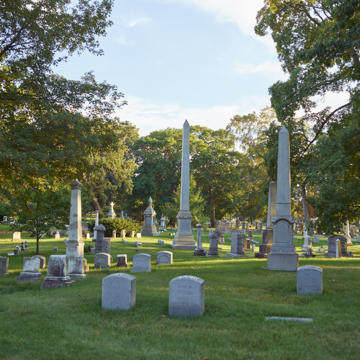St. Paul’s Episcopal parish founded this cemetery, which comprises nearly two hundred acres of winding roads, rolling hills, and trees. Around 1830, a national park cemetery movement advocated picturesque cemetery settings with meandering roads and naturalistic plantings. Only Detroit’s Elmwood Cemetery, started in 1846, predates Forest Home—consecrated in 1850—as the oldest midwestern cemetery of this type. Milwaukee cartographer, engineer, surveyor, and zoologist Lapham created the original landscape design, drawing on his botanical knowledge and the influence of eastern romantic landscape architects. Later features, including an artificial pond with a double-arched stone bridge, were added to complement Lapham’s romantic design.
The major architectural feature is a chapel built in 1892 of red sandstone and ashlar trim, with a crematory added to the east end in 1896. Highlighting the chapel exterior are a porte-cochere, a stocky tower, and two wood-framed and glass-walled conservatory wings. Visitors pay their respects in the chapel’s austere nave with a Gothic-inspired timber truss ceiling. The wood paneling and altar are original to the 1892 construction, as are the carved ends of the rebuilt pews.
Before Milwaukee’s public park system began in the 1890s, Forest Home Cemetery was popular for picnics and recreation. Graves include those of Milwaukee’s beer barons, including an elaborate column for Joseph Schlitz (1875); the Romanesque Revival mausoleum of Valentine Blatz (1894) made of white granite with elaborate ironwork strapping the oak crypt door; and a simple gray granite headstone emblazoned “Father” for Captain George Pabst (1901) near the family crypt. Other notable Milwaukeeans buried here include typewriter inventor Christopher Latham Sholes (1890); industrialist Edward Allis (1889) in a Classical Revival marble mausoleum with Ionic columns supporting the pediment above the entrance; suffragist Mathilde Anneke (1884); Governor Francis McGovern (1946); Socialist congressman Victor Berger (1929); motorcycle manufacturer William Davidson (1939) in a granite crypt; twentieth-century stage actors Alfred Lunt (1977) next to his wife Lynn Fontanne (1983) in a white granite tomb; and Wisconsin chief Supreme Court justice Edward Ryan (1880), whose grave is marked with a tall white granite obelisk.





















